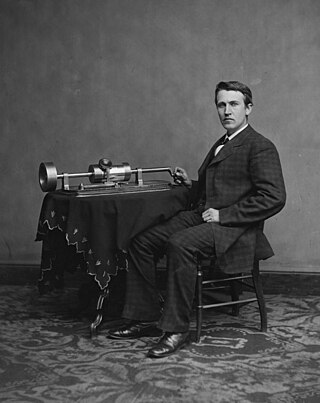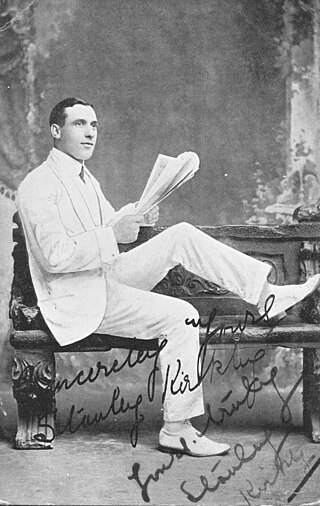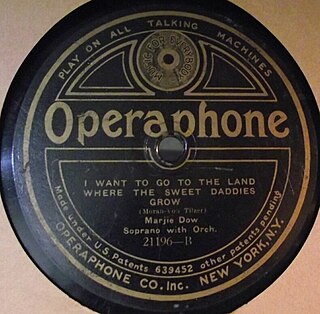
A phonograph, later called a gramophone, and since the 1940s a record player, or more recently a turntable, is a device for the mechanical and analogue reproduction of recorded sound. The sound vibration waveforms are recorded as corresponding physical deviations of a spiral groove engraved, etched, incised, or impressed into the surface of a rotating cylinder or disc, called a "record". To recreate the sound, the surface is similarly rotated while a playback stylus traces the groove and is therefore vibrated by it, very faintly reproducing the recorded sound. In early acoustic phonographs, the stylus vibrated a diaphragm which produced sound waves which were coupled to the open air through a flaring horn, or directly to the listener's ears through stethoscope-type earphones.

Charles Taze Russell, or Pastor Russell, was an American Adventist minister from Pittsburgh, Pennsylvania, and founder of the Bible Student movement. He was an early Christian Zionist.

A number of corporations are in use by Jehovah's Witnesses. They publish literature and perform other operational and administrative functions, representing the interests of the religious organization. "The Society" has been used as a collective term for these corporations.

Nipper, also known as the RCA Victor dog, was a dog from Bristol, England, who served as the model for a 1898 painting by British painter Francis Barraud titled His Master's Voice. This image became one of the world's best known trademarks, the famous dog-and-gramophone pairing that was used by several record companies and their associated company brands, including Berliner Gramophone and its various affiliates and successors, among them Berliner's German subsidiary Deutsche Grammophon; Berliner's American successor the Victor Talking Machine Co. ; Zonophone; Berliner's British affiliate the Gramophone Co. Ltd. and its successors EMI and HMV Retail Ltd.; the Gramophone Co.'s German subsidiary Electrola; and onetime Victor subsidiary the Japan Victor Company (JVC).

The Victor Talking Machine Company was an American recording company and phonograph manufacturer, incorporated in 1901. Victor was an independent enterprise until 1929 when it was purchased by the Radio Corporation of America (RCA) and became the RCA Victor Division of the Radio Corporation of America.

Emile Berliner originally Emil Berliner, was a German-American inventor. He is best known for inventing the lateral-cut flat disc record used with a gramophone. He founded the United States Gramophone Company in 1894; The Gramophone Company in London, England, in 1897; Deutsche Grammophon in Hanover, Germany, in 1898; and Berliner Gram-o-phone Company of Canada in Montreal in 1899. Berliner also invented what was probably the first radial aircraft engine (1908), a helicopter (1919), and acoustical tiles (1920s).

Awake! is an illustrated religious magazine published by the Watch Tower Bible and Tract Society of Pennsylvania. It is considered to be a companion magazine of The Watchtower, and is distributed by Jehovah's Witnesses. The Watch Tower Society reports worldwide circulation of about 31.5 million copies per issue in 216 languages.
Discography is the study and cataloging of published sound recordings, often by specified artists or within identified music genres. The exact information included varies depending on the type and scope of the discography, but a discography entry for a specific recording will often list such details as the names of the artists involved, the time and place of the recording, the title of the piece performed, release dates, chart positions, and sales figures.

The overwhelming majority of records manufactured have been of certain sizes, playback speeds, and appearance. However, since the commercial adoption of the gramophone record, a wide variety of records have also been produced that do not fall into these categories, and they have served a variety of purposes.
Kingdom songs are the hymns sung by Jehovah's Witnesses at their religious meetings. Since 1879, the Watch Tower Society has published hymnal lyrics; by the 1920s they had published hundreds of adapted and original songs, and by the 1930s they referred to these as "Kingdom songs" in reference to God's Kingdom.

The Bible Student movement is a Millennialist Restorationist Christian movement. It emerged in the United States from the teachings and ministry of Charles Taze Russell (1852–1916), also known as Pastor Russell, and his founding of the Zion's Watch Tower Tract Society in 1881. Members of the movement have variously referred to themselves as Bible Students, International Bible Students, Associated Bible Students, or Independent Bible Students.
The Dawn Bible Students Association is a Christian organization and movement, and a legal entity used by a branch of the Bible Student movement.
Jehovah's Witnesses originated as a branch of the Bible Student movement, which developed in the United States in the 1870s among followers of Christian restorationist minister Charles Taze Russell. Bible Student missionaries were sent to England in 1881 and the first overseas branch was opened in London in 1900. The group took on the name International Bible Students Association and by 1914 it was also active in Canada, Germany, Australia and other countries.
"Faithful and discreet slave" is the term used by Jehovah's Witnesses to describe the group's Governing Body in its role of directing doctrines and teachings. The group is described as a "class" of "anointed" Christians that operates under the direct control of Jesus Christ to exercise teaching authority in all matters pertaining to doctrine and articles of faith.

The Photo-Drama of Creation, or Creation-Drama, is a four-part audiovisual presentation produced by the Watch Tower Bible and Tract Society of Pennsylvania under the direction of Charles Taze Russell, the founder of the Bible Student movement. The presentation presents their beliefs about God's plan from the creation of the earth through to the end of the 1,000 year reign of Christ.
Archeophone Records is a record company and label founded in 1998 to document the early days of America's recording history. It was started by Richard Martin and Meagan Hennessey, a husband and wife who run the company in Champaign, Illinois. Archeophone restores and remasters audio from cylinders and discs of jazz, popular music, vaudeville, and spoken word recordings.

Ernest George Pike was an English tenor of the early 20th century who made numerous recordings in the first decades of the 20th century. After studying at the Guildhall School of Music in London, he worked as a bank clerk and sang as a church tenor before making his first recording "Take a Pair of Sparkling Eyes" for the Gramophone & Typewriter Company in 1904. He became the house tenor for HMV and made several hundred records in a career that spanned over twenty years.

Stanley Kirkby was an English baritone singer and variety artist of the early 20th century. He sang ballads and popular songs of the Edwardian era, the First World War and the inter-War period. He sang mostly in music halls and variety theatres and was a popular recording artist.

Aretino was a United States record label, in business from about 1907 to 1914.

Operaphone Records was a record company in existence from 1915 until 1921, who released numerous phonograph records cut in the hill-and-dale and universal-cut methods.



















